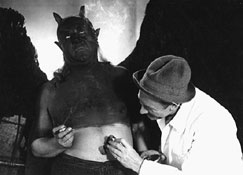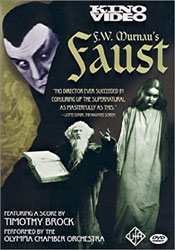|
|
|
|
|
 |
 |
|
| |
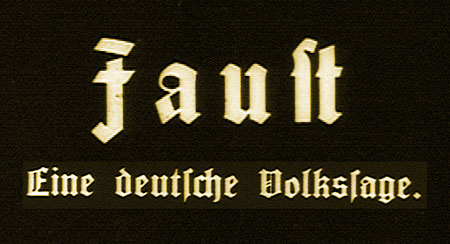
Faust — Eine deutsche Volkssage
|
|
|
| |
 |
Deutschland 1926 | 119 Minuten (18 Bilder/sec) | 7 Akte, 2.443 m
Regie: Friedrich Wilhelm Murnau
Produzent: Erich Pommer
Produktion: UFA Universum-Film AG, Berlin
Drehbuch: Hans Kyser; nach Motiven von Johann Wolfgang von Goethe, Christopher Marlowe, der Faust-Sage sowie dem Manuskript «Das verlorene Paradies» von Ludwig Berger
Kamera: Carl Hoffman (s/w, 1.33:1); Assistenz: Erich Grohmann, Charles Rosher (Hospitanz)
Musik: Werner Richard Heymann; unter Verwendung von Motiven von Richard Wagner und Richard Strauß
Bauten: Robert Herlth, Walter Röhrig, Arno Richter (Assistenz)
Kostüme: Robert Herlth, Walter Röhrig, Georges Annenkov (Assistenz)
Requisite: Robert Basilice, Meyer
Maske: Waldemar Jabs
Drehorte: UFA-Atelier Berlin-Tempelhof, September 1925 – Mai 1926
Darsteller: Gösta Ekman (Faust), Emil Jannings (Mephisto), Camilla Horn (Gretchen), Frida Richard (Mutter), Wilhelm Dieterle (Bruder Valentin), Yvette Guilbert (Marthe Schwerdtlein), Eric Barclay (Herzog von Parma), Hanna Ralph (Herzogin von Parma), Werner Fütterer (Erzengel), Hans Brausewetter (Bauernbursche), Lothar Müthel (Mönch), Hans Rameau, Hertha von Walther, Emmy Wyda
Premiere: 14 September 1926, Wien (Voraufführung) | 26 August 1926, Berlin (U.T. Nollendorfplatz) | Offizielle Premiere: 14 Oktober 1926, Berlin (UFA-Palast am Zoo) | US-Premiere: 5 December 1926, New York (Capitol)
Restored version: Luciano Berriatúa in cooperation with: Filmoteca Española Madrid, Federal Film Archive Berlin, German Institute for Film Studies Wiesbaden, Friedrich Wilhelm Murnau Foundation Wiesbaden
Der Filmhistoriker Luciano Berriatúa hat fünf unterschiedliche Fassungen deutsche, je eine amerikanische und französische Version) identifiziert und 1994 für die Filmoteca Española, Madrid, ein Video hergestellt, das die Abweichungen (Titel, Takes, Kamerastandpunkte) dokumentiert.
|
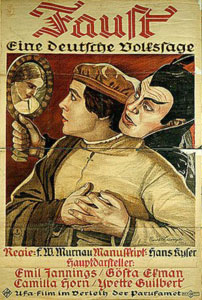
|
|
 International Movie Database International Movie Database
|
 All-Movie Guide All-Movie Guide |
|
|
| |
 |
|
| |
Faust was the mammoth German production which won F. W. Murnau his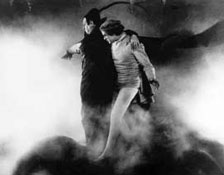 contract with Hollywood's Fox Studios. Emil Jannings glowers his way through the role of Mephistopholes, who offers the aging Faust (Gosta Eckman) an opportunity to relive his youth, the price being Faust's soul. Though highly stylized, the film is unsettlingly realistic at times, especially during the execution of the unfortunate Gretchen. Even in old age, actress Camilla Horn could recall how close she came to genuine immolation when Murnau burned her at the stake. An American version of Faust had been planned earlier as a Mary Pickford vehicle, but Pickford's mother wanted no part of a film in which her darling daughter strangled her own baby. The scenario for Faust touches lightly upon the previous retellings by Goethe and Marlowe, but is more heavily reliant on the paintings of Pietr Breughel. contract with Hollywood's Fox Studios. Emil Jannings glowers his way through the role of Mephistopholes, who offers the aging Faust (Gosta Eckman) an opportunity to relive his youth, the price being Faust's soul. Though highly stylized, the film is unsettlingly realistic at times, especially during the execution of the unfortunate Gretchen. Even in old age, actress Camilla Horn could recall how close she came to genuine immolation when Murnau burned her at the stake. An American version of Faust had been planned earlier as a Mary Pickford vehicle, but Pickford's mother wanted no part of a film in which her darling daughter strangled her own baby. The scenario for Faust touches lightly upon the previous retellings by Goethe and Marlowe, but is more heavily reliant on the paintings of Pietr Breughel.
While not as well known today as Nosferatu or The Last Laugh, Faust is perhaps director F.W. Murnau's masterpiece; few films by any director can match it for the sweeping impact and beauty of its visuals or the power of its storytelling. Murnau approaches Goethe's tragedy of a man who learns all too well the price of his soul with appropriately broad dramatic strokes, and if the effect seems a bit over the top in the early reels, it hits with full melodramatic force at the end; the full, horrible impact of Faust's comeuppance is as disturbing today as it was in 1926. Gosta Ekman is fine as the luckless Faust and Emil Jannings is brilliant as Mephisto, the embodiment of cunning and evil. And the camerawork by Carl Hoffman and production design by Robert Herlith and Walter Rohrig are nothing short of astounding, creating a brilliantly controlled and beautifully painterly visual sense that's the ideal backdrop for this fable. Anyone who thinks of silent films as sluggish and amateurish has obviously never seen Faust; the home video release on Kino compliments the film's striking visuals with a superb original score by the American composer Timothy Brock that's worthy of attention on its own merits.
One of the most beautifully crafted films ever made. Black-and-white cinematography was redefined in Faust: this is a film shot in darkness and light. Lotte Eisner's elegiac description sets the mood for Murnau's version of the Faust legend, starring Emil Jannings as the subtly mischievous Mephistopheles, and Swedish actor Gosta Ekman as a subtly homoerotic Faust: "This film starts with the most remarkable and poignant images the German chiaroscuro ever created. The chaotic density of the opening shots, the light dawning in the mists, the rays beaming through the opaque air, are breathtaking... No other director, not even Lang, ever succeeded in conjuring up the supernatural as masterfully as this. The entire town seems to be covered by the vast folds of a demon's cloak (or is it a gigantic, lowering cloud?) as the demoniac forces of darkness prepare to devour the powers of light. Carl Hoffmann's camera gives the terrestrial part of this film extraordinary modeling and has the power of impregnating everything, down to the cloth of a garment, with diabolism..."
"Faust was one of the most pictorially beautiful films ever made, a supreme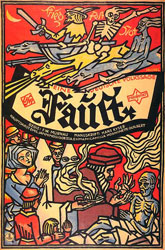 example of German studio craftsmanship, at times seeming like a Dürer or Bruegel come to life. The expressionistic medieval settings were beautifully lighted; strange apparations and weird camera tricks added a mystical atmosphere; low angles and ceilings were again employed. In the famous scene where Mephisto and the rejuvenated Faust fly through the air, the camera, placed on a roller coaster device, travelled over miles of miniature cities and country. example of German studio craftsmanship, at times seeming like a Dürer or Bruegel come to life. The expressionistic medieval settings were beautifully lighted; strange apparations and weird camera tricks added a mystical atmosphere; low angles and ceilings were again employed. In the famous scene where Mephisto and the rejuvenated Faust fly through the air, the camera, placed on a roller coaster device, travelled over miles of miniature cities and country.
The leading role was played by Gösta Ekman, noted Swedish actor, who was able to project successfully the extreme contrast between youth and old age.... But ... it was Emil Jannings who ran away with the picture, dressed in a long black cape to make him appear more slender, and playing with mischief and subtle humor a very delightful Mephistopheles. In fact, it was a conception and treatment of Mephisto which overbalanced the picture; the main theme of Faust was lost, as well as any genuine emotional quality...."
Theodore Huff: "An Index to the Films of F.W. Murnau", in: Sight & Sound
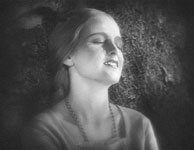 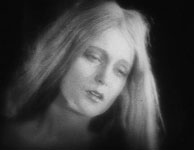
Die sublime Camilla Horn als Gretchen
|
The devil claims the earth as his own. A dazzling archangel declares it is not and never will be so. The devil proposes a wager for possession of Earth. If he can corrupt but one man, Faust, all the earth will be his. If he loses, he must leave back to Hell. The devil hovers over Faust's village. Plague, death, panic, frustration, resignation. Faust is pious, but cannot call upon God successfully to lift the veil of death. In a moment of false revelation, Faust is tempted to call upon the devil. The wry devil manuevers Faust into accepting dark powers for a day. Faust cures some of the plague, but is outcast when he cannot bring himself to touch a crucifix. Not realizing his new powers have already failed the test, he accepts the devil's temptation of youth. The devil has his way. Slowly, all Hell breaks loose (so to speak). In fact, the devil really is a son of a bitch. Faust falls for the pure Gretchen, but under the guidance of the devil Faust corrupts Gretchen. She struggles through the birth of their child and its death. But amidst all this suffering, which the devil is really enjoying, something happens to redeemthe tragic situation.
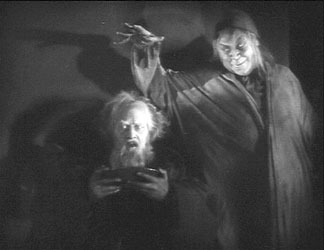
Emil Jannings' performance as the devil in Faust is both charming and mirthful. Under F.W. Murnau's direction, Jannings expertly hits dramatic poses that look as though they are modelled after a stylized illustration. But can it be something other than posing that Jannings, a truly great actor, brings to the role? Some modern critics make Jannings out to be nothing more than a pompous overactor. We say that Jannings' Faust role must be taken as a visual device at director Murnau's control first and as characterization and a plot device a distant second. Gösta Ekman as Faust has far more to do with his character and his performance. All characters and situations revolve, like a medieval concept of the solar system, around Faust. Faust is the one who changes during the course of the film. Camilla Horn is lovely as Gretchen in her first real film role.

But what of the overall effect of the film on viewers? Murnau does depart from the text of plays and legends. The film cannot be considered a faithful adaptation of the Goethe play. But isn't it something more? Something representative of a new art? At its most shallow assessment, the film is nothing more than stylistic eye candy. A more sympathetic and enthusiastic assessment of the film places it as one of greatest achievements of German silent cinema and of the UFA studio in particular. Murnau had carte blanche access to UFA resources to help bring his vision to celluloid. Faust is a triumph of art direction, costume design and makeup. Texture, light and shadow, and movement within the frame are all of upmost importance. Nearly every shot is framed dynamically; either centered to indicate the balance of divinity, otherwise framed in strong angles, tilted framing, and dynamic composition. Nearly every shot indicates the deliberate visual design of director Murnau. Faust features some of the most striking images committed to film, and it is nothing short of a stylistic masterpiece. Our own first encounter with Faust was of jaw-dropping awe. We find ultimately that the film serves the viewer first as a rich Germanic fantasy, and second as a special-effects extravaganza.

|
| |
 |
| |
|
|
|
| |
 |
DVD
|
Faust
Kino on Video
|
| Länge: |
115:32 min |
| Video: |
1.30:1/4:3 FullScreen
|
| Bitrate: |
4.89 mb/s
|
| Audio: |
Orchestral Score Dolby Digital 2.0 Stereo by Timothy Brock
|
| Untertitel: |
English intertitles
|
| Features: |
• The Making of Faust: A Gallery of Production Stills
• 4-pages Booklet with Liner Notes by Jan Christopher Horak
|
| DVD-VÖ: |
5 June 2001 |
|
Keep Case
Chapter stops: 18
DVD Encoding: NTSC Region 1
SS-SL/DVD-5
Produced for DVD by David Shepherd from an original English language print
Licensed by Transit Films on behalf of the Friedrich-Wilhelm Murnau Stiftung Wiesbaden
|
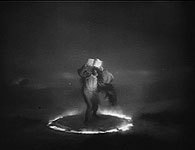
Image Transfer: The 35mm source materials used here are generally in very good to excellent condition. As expected, there is flickering and speckling, with an occasional flash, but nothing that constitutes major damage. The last few reels, including Faust's combat with Valentin (Wilhelm Dieterle) are so shrouded in shadow as to be nearly unreadable. Other portions are quite high in contrast, but overall an acceptable presentation of a 75-year-old film. The picture is in black and white, without tints.
Audio Transfer: The sole audio track is a Dolby Surround presentation of a 1996 orchestral score by Timothy Brock. This music is quite appropriate to the film throughout, and occasionally discordant in a manner that fits the 1920s origins of the movie. No attempt was made at directionality as far as I was able to discern. The sound is clear and rather noise-free. Bass extension is rather lacking but the audio is otherwise quite good.
Extras Review: The extras provided are not very substantial. A brief essay on the film by historian Jan Christopher Morak is included on the single sheet pamphlet. A series of about two dozen behind the scenes shots and production stills comprise what is billed on the case as "UFA Studios 1925: The Making of Faust", but no narration or information of any kind is provided to indicate what or whom the viewer is looking at. Two shots of the US pressbook are also included, and I would have liked to have seen much more of this Art Nouveau-influenced piece of ephemera. Chaptering is decent. The chapter menu has a still of each chapter, and when the cursor moves over it, a calligraphic representation of the chapter number in Roman numerals appears, which I thought was a nice touch appropriate to the film.
The presentation of Faust in this Kino edition is virtually identical to the 1996 laserdisc and videotape editions. A very good 35mm print, with some speckling, processing inconsistencies, emulsion damage and scratches, has been utilized by edition producer David Shepard. The image framing appears to be generous, with no distracting or obvious cropping. The video transfer is otherwise detailed with well balanced graytones that hold image detail in deep shadows. There is so much smoke in this film, and smoke is so hard to render smoothly under MPEG-2 video compression, there are bound to be several opportunities to notice compression artifacts in the DVD edition. There is generally a flatness to the many graytones that make up moving smoke and some posterization of the subtle gray transitions can be noticed if you are looking for it. Otherwise the video transfer appears to be flawless.
The print features main titles in German, but all of the film's intertitles have been digitally set in English (in the American Uncial typeface) and made to look contemporary to the print, which we think is unnecessary if they are not the original intertitle cards.
Another fine orchestral score by Timothy Brock and the Olympia Chamber Orchestra accompanies the film. Brock manages to evoke musical images in a Germanic tone, and that ominous tone is always an appropriate mood setter for this film. We wish that all video editions of silent era films could afford this orchestral treatment.
|
|
|
|
|
|
|
| |
![[filmGremium Home]](../../image/logokl.jpg) |
|
|

![[filmGremium Home]](../../image/logokl.jpg)


 contract with Hollywood's Fox Studios. Emil Jannings glowers his way through the role of Mephistopholes, who offers the aging Faust (Gosta Eckman) an opportunity to relive his youth, the price being Faust's soul. Though highly stylized, the film is unsettlingly realistic at times, especially during the execution of the unfortunate Gretchen. Even in old age, actress Camilla Horn could recall how close she came to genuine immolation when Murnau burned her at the stake. An American version of Faust had been planned earlier as a Mary Pickford vehicle, but Pickford's mother wanted no part of a film in which her darling daughter strangled her own baby. The scenario for Faust touches lightly upon the previous retellings by Goethe and Marlowe, but is more heavily reliant on the paintings of Pietr Breughel.
contract with Hollywood's Fox Studios. Emil Jannings glowers his way through the role of Mephistopholes, who offers the aging Faust (Gosta Eckman) an opportunity to relive his youth, the price being Faust's soul. Though highly stylized, the film is unsettlingly realistic at times, especially during the execution of the unfortunate Gretchen. Even in old age, actress Camilla Horn could recall how close she came to genuine immolation when Murnau burned her at the stake. An American version of Faust had been planned earlier as a Mary Pickford vehicle, but Pickford's mother wanted no part of a film in which her darling daughter strangled her own baby. The scenario for Faust touches lightly upon the previous retellings by Goethe and Marlowe, but is more heavily reliant on the paintings of Pietr Breughel.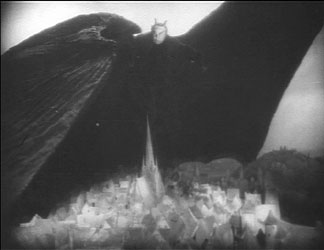

 example of German studio craftsmanship, at times seeming like a Dürer or Bruegel come to life. The expressionistic medieval settings were beautifully lighted; strange apparations and weird camera tricks added a mystical atmosphere; low angles and ceilings were again employed. In the famous scene where Mephisto and the rejuvenated Faust fly through the air, the camera, placed on a roller coaster device, travelled over miles of miniature cities and country.
example of German studio craftsmanship, at times seeming like a Dürer or Bruegel come to life. The expressionistic medieval settings were beautifully lighted; strange apparations and weird camera tricks added a mystical atmosphere; low angles and ceilings were again employed. In the famous scene where Mephisto and the rejuvenated Faust fly through the air, the camera, placed on a roller coaster device, travelled over miles of miniature cities and country.






